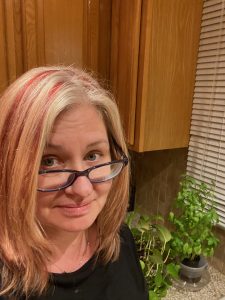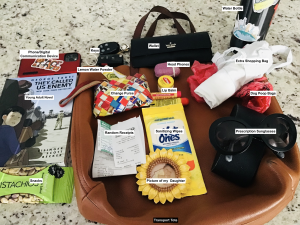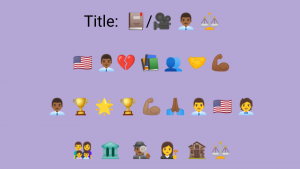 This task is based on Ellie Brown’s bag series that “explores the duality between the way people characterize themselves in public and the private contents of their handbags”.
This task is based on Ellie Brown’s bag series that “explores the duality between the way people characterize themselves in public and the private contents of their handbags”.
Tada! The contents of my transport tote, a gift from my daughter, many Mother’s Days ago. This is my everyday bag, not my school bag, on school days I carry at least two bags and sometimes more. This however is the stuff I feel is important enough, that I tote it around whenever I leave the house on any given day. Most of it is for practical purposes, and some for comfort.

- Phone/Digital Communication Device
- Wallet
- Keys
- Prescription Sunglasses
- Water Bottle
- Lemon Powder
- Snacks
- Lip Balm
- Sanitizing Wipes
- Change Purse- which also functions as a mini medicine holder
- Picture of my daughter
- Young Adult Graphic Novel
- Extra shopping bag
- Dog Poop Bags
- Random Receipts
This stuff begins to tell the story of who I am based on what I carry with me. The specific contents may vary over time, but the items pictured here are pretty much the ones I carry consistently.
My phone, today, is the most vital item in my bag, although it does so much more, maybe digital communication device is a better label. As a communication device, it incorporates written text, visual graphics, and oral/audio modalities. It uses text for communication, text messaging and email, for entertainment, reading a story on Facebook or watching TikToc videos. It keeps me up-to-date on news and event and provides me with driving direction regularly. My phone also is useful for information storage, grocery list and contact list, especially since it seems that people, myself included do not remember phone numbers anymore. This device/phone also holds my credit card information, Apple Pay is a wonderful convenience, I no longer have to carry more plastic cards than necessary. I can use it to gain access to different venues by showing my ticket barcode on the screen. This digital communication device, referred to commonly as my phone is a compelling example of how text communication has changed over the years. Today writing messages and communicating has become increasingly abbreviated and graphic, with emojis allowing easier expression of emotions and tone through written communications. If I lost this device, I would be lost, I depend on it for so many functions.
My wallet contains both personal and financially sensitive information about me. My driver’s license, and debit/credit cards all provide digital information about me by accessing databases, They send messages about transactions and record my purchasing and location behaviours
My car keys may indicate I live in a place that requires a vehicle to get around. House keys and fobs to access the garage and house, we lock everything up because this is the society in which we live, and we value our personal effects. Both sets of keys contain digital information that allows me to carry out certain functions in my day-to-day life.
Prescription Sunglasses, these are necessary for me to see, especially when driving. I also need my glasses to take in and process both print and digital media.
A water bottle, lemon powder, and snacks just in case I find myself hungry or thirsty and these things are not available to me.
I use lip Balm (3) frequently and always have one in my coat pocket so I am not surprised I have so many in my bag. Sanitizing wipes, because you never know when you may need to clean the area where you sit down, maybe for lunch or coffee or to write a paper. My change purse has coins for parking, but more importantly, it functions as a mini medicine bag containing items such as Motrin, dental floss, Tums and a variety of other “like” stuff. These items are all printed with directions for use.
As another example of print media, sentimentally, I have kept a picture of my daughter as a baby in my bag since she went away to university in 2013. Of all the treasured images of her I have on my phone, I just can’t seem to remove this little framed picture from my everyday bag. I take comfort knowing I have that picture.
Young adult graphic novel: In most aspects of my life, technology is integrated, I have an iPad with a Kindle app on it, but I still prefer my books in print. I enjoy reading print media for enjoyment and relaxation, and I like to keep up with YA novels to make reading recommendations for my students. I teach grades 6-8, and I am trying to instill the love of books and reading for pure enjoyment in students, although it is a challenge competing with the digital media world.
Extra shopping bag just in case I am out and need to pick a few things up at the store, I definitely do not need any more bags, so I always try to carry an extra one with me.
Dog poop bags tell you that I am a responsible dog owner.
These items in my bag would indicate that I am literate in both print and digital media, and I can switch between traditional and digital media depending on my needs.
What would my bag have looked like twenty years ago?
Twenty years ago amazingly I also had a cell phone, it was a Motorola flip phone, or maybe it was a little Blackberry, I can’t be sure. I do remember the reason I had gotten it in the first place was that my car broke down and I was stranded. It was an essential safety item then, and today, it contains “everything” essential to my day-to-day life. I have always carried a wallet with the necessary cards and cash. A first or second-generation iPod with headphones for listening to music, music has always been a refuge. I was also a working mother of a seven-year-old, so my bag was full of snacks for after school, children’s books, games, and crayons for passing the time in the car, riding the train or waiting for appointments. How time flies, and how quickly technology, items in our bags, and life change.








